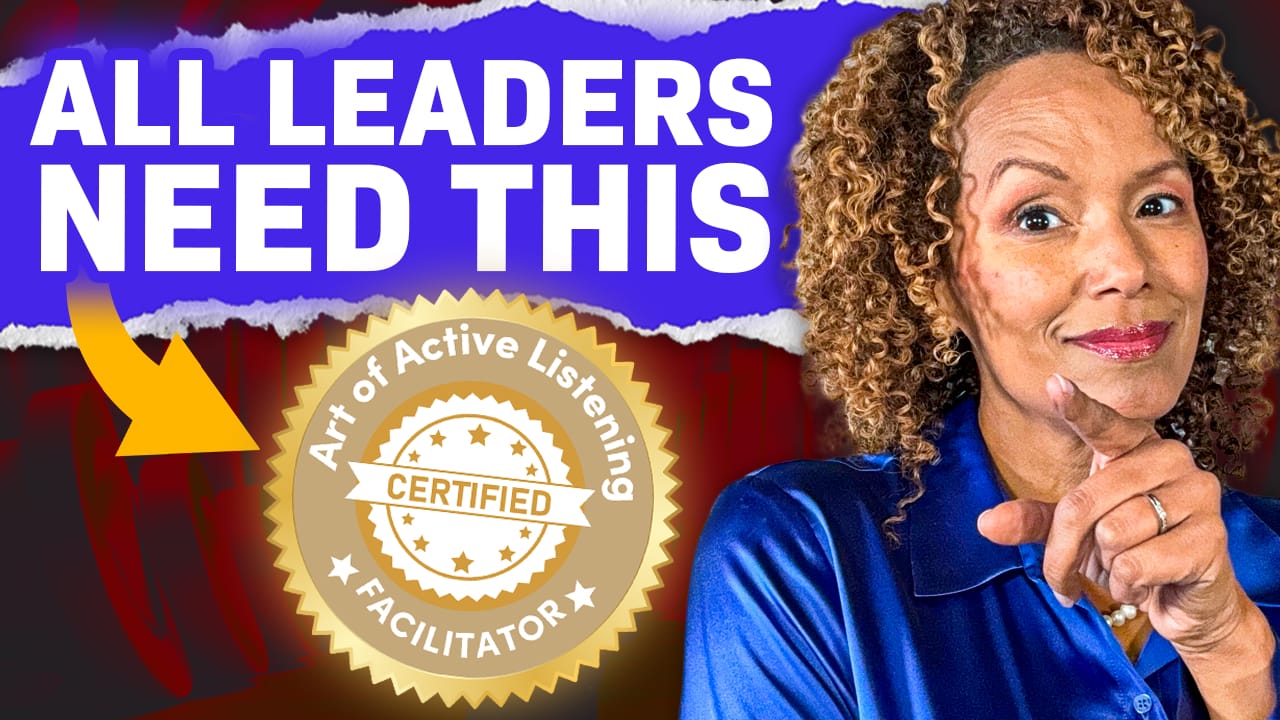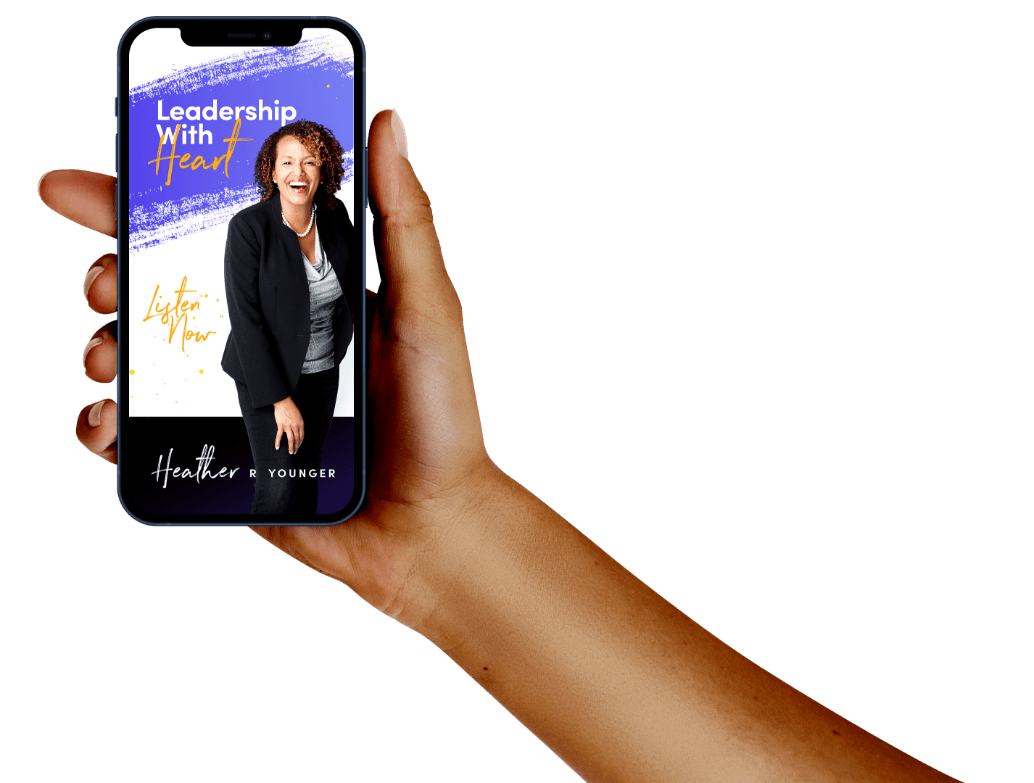Subscribe to the Leadership with Heart Podcast!
In this episode, Heather has an insightful conversation with four of the six founding facilitators of the Certified Active Listening Program: Sherry Martin, Mike Chanat, Laurent Pierre JR, and Kaydie Paschall. Each of these accomplished individuals offers a distinctive perspective on their motivations for obtaining the certification and how they integrate active listening into their professional roles (and home life too). They are all from various sectors, including global corporate leadership and human resources; this diverse group of facilitators provides insight into how the certification has transformed their thinking and communication styles in all aspects of their lives.
Why Leaders Should Get Active Listening Certified
I realized how important it is to listen when I was working for an organizational leader who was second in command.
I was frustrated because what they hired me to do, improve and sustain customer experience for their large population of residents, was becoming next to impossible. The leadership team had other priorities, and my efforts were stalled.
After hitting the proverbial “wall” many times, I began to silo myself and put my head down in defeat.
One day, my boss spontaneously knocks on my office door.
I was thinking, “Oh boy, what did I do now?”
Then he comes in with a big smile on his face, and he says, “Heather, I know you are frustrated and that you are trying to do a good job; please just keep doing what you are doing. Do what you were hired to do. You might think that the leadership team is stopping you from doing what you set out to do, but please be patient with us and know that we are proud of the work you have done so far; I just wanted you to know that.”
At that moment, I felt seen and important. He paid attention to the unspoken cues of my disconnect with his heart, his eyes, and his ears. This made me want to do more for him and go over and above anything he needed me to do.
This is why I believe every leader should be armed with an Art of Active Listening Certification. But don’t just take it from me. On a recent podcast, I spoke with many of the founding facilitators of my new Certified Art of Active Listening program. Below is some of what they shared with the world about the need to consider becoming certified.
Read their words, and then let me know if you are also a change catalyst for great listening at work.
This is part of the Leadership at Heart Podcast, with four leaders of different types of companies talking about their experiences with their employees.
They need to listen and bring it back
You need to be listening to what they are telling you and getting enough information from people. One of the main points that According to Mike Chanat, he said that “he found himself being a little more aware with what I tell people and to follow up with things I found through your program and the need to understand them and to get to follow up with them, tell them what you are going to do and close the loop, and then start bringing it back.” So, then you can take what information they said and bring that straight home with you for learning purposes. It is super important to make sure that you are all eyes on the person who is speaking to you. Having all distracting screens put away, and listening intently so that the person knows that you fully care about what they have to say and want to help them out in any possible way.
Pause, listen, and move forward
Make sure to be present with that person and decode the information that I have with that person. Leaning in more to what the person is saying, paying attention to the body language of that person, and focusing more on the unsaid. Sherry Martin says that what is most important is “to see the credibility of the work that I do within human resources and to follow the five-step model to make sure people are experiencing me from that space”. This then allows for people to feel seen, heard, and understood at work with diversity. Just use the small little steps.
Take action from that active listening
If you do not act on that active listening to that person, you are. It is the desire to be better and to improve your active listening skills. Listening differently and then responding differently. This then shows the person or group that you are talking to that they are being fully seen and heard and that they know they feel comfortable to keep coming back to you. Another leader giving feedback on the active listening certification. Laurent Pierre said, “I have an 87-year-old father who needs a lot of medical attention and help at home…he used to be a general manager as funny as that is he does not like being codependent on anyone…at 9 pm he says it is time for eggs and bacon, so I try to make sure I listen intently so that he knows I hear him and understand him”. This was his way of showing that he cares.
Telling them that they understand and feel what they are going through
Try to seek to understand how they feel and how it all made them feel. Mike also puts listening to employees as making sure you are aware of what they may be going through, struggling with, or with any questions they may have or if they just need some reassurance from their leader that they truly care about them. They will begin to feel more comfortable around you and more open to what they say and how they feel. Over time, try to find a solution to how they are feeling and what they are doing. Maybe say something like these are the steps that I am taking to get what you need. So that they know for a fact that you are being proactive.
Building trust and relationships
Wanting to feel safer and comfortable around you by giving them the time to just share how they are feeling and show them that you care about them and are tuning into what they are saying. You need to reassure that person that they can trust you with sensitive and very personal information about them and what could be happening in their lives so that you can establish a strong relationship with them.
With all of this aside, to make sure that you are truly a caring leader in active listening, you need to listen fully to what is being said by the person in the group to build strong relationships and so forth. You need to listen to the person very intently so that you can then know how to utilize what was said so that you can be a better leader. Also, you need to start acting from all the listening you have been doing and create that positive change for your employees and for whomever you were intently listening to. Lastly, to cultivate stronger and more trust-fulfilling relationships and meet people where they are on their journey.
Watch the podcast in video here
Become a Certified Art of Active Listening Facilitator
Transforming culture isn’t difficult if you have the right support.
- Are you overwhelmed with possibilities but don’t know where to start?
- Do you struggle internally to get everyone on the same page?
- Think you don’t have time to create lasting change?
Are you ready to become a high-value leader who champions change in your organization through effective and caring leadership?
1. Expand Your Knowledge Base
2. Develop New Leadership Skills
3. Transform Your Organization
Mentions
Connect with Heather on LinkedIn
Get to know the founding facilitators here
Subscribe, rate, and review the podcast on Apple Podcasts
Listen to the podcast on Spotify
Connect with Heather
WHEN YOU’RE READY, HERE’S HOW WE CAN HELP:
Engage your people with work culture consulting:
https://employeefanatix.com/
Hire Heather to speak to your group:
https://www.heatheryounger.com
Access free Art of Caring Leadership resources:
https://www.caringleadership.co/free-downloads
Let’s connect on social
https://linktr.ee/heatheryounger
About Heather R Younger
Heather R Younger is a highly sought-after speaker, 2x-TEDx speaker, diversity, equity and inclusion strategist, and contributor to leading news outlets. She is also the Founder and CEO of Employee Fanatix, a leading employee engagement and consulting firm.
After over 25,000 employee engagement surveys and years of working with organizations to transform employee engagement, here’s what Heather has seen over and over:
When you know how to listen, employees will tell you exactly what they need to bring their full selves to work.
Book Heather to speak at your event or organization. Visit heatheryounger.com or https://www.cmispeakers.com/heather-r-younger for more details.
















